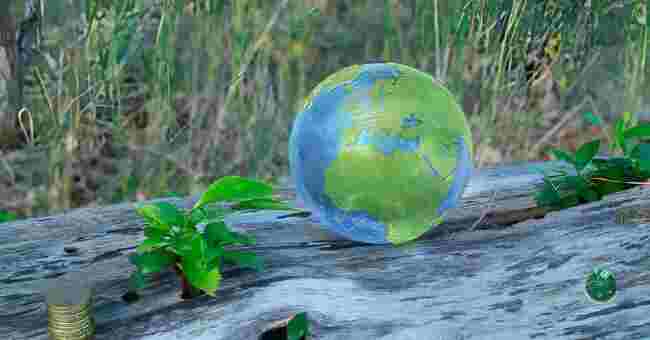Table of Contents
How can conservation finance and ecological restoration help in restoring habitats for biodiversity? Absolutely, conservation finance and ecological restoration are crucial for revitalizing degraded habitats and safeguarding biodiversity.
I vividly remember my childhood spent exploring the lush forests near my hometown, teeming with diverse flora and fauna.
However, over the years, I witnessed the gradual degradation of these natural wonders due to human activities and neglect. It was a heartbreaking experience, seeing once-vibrant ecosystems wither away.
Drawing from personal experiences and expertise, I’ll delve into the powerful synergy between conservation finance and ecological restoration, shedding light on innovative strategies to revive habitats and promote biodiversity. Join me on this journey as we explore practical solutions to restore nature’s balance and ensure a sustainable future for generations to come.
The Importance of Habitat Restoration

Healthy habitats are the foundation of biodiversity. From lush forests to vibrant coral reefs, these ecosystems provide homes for countless species, supporting intricate food webs and ecological processes.
However, human activities such as deforestation, pollution, and urbanization have severely damaged or destroyed many of these crucial habitats, placing countless species at risk of extinction.
Ecological restoration aims to repair and revitalize degraded habitats, creating conditions conducive to the return of native flora and fauna. This process involves various techniques, including reforestation, wetland restoration, and the reintroduction of keystone species. By restoring habitats, we not only protect biodiversity but also contribute to the overall health and resilience of our planet.
Financing Conservation Efforts
While the importance of ecological restoration is widely acknowledged, securing adequate funding remains a significant challenge.
Traditional sources of funding, such as government grants and philanthropic donations, are often insufficient to meet the growing demand for conservation initiatives. This is where conservation finance comes into play, offering innovative solutions to bridge the funding gap.
One promising approach is the use of impact investments, which seek to generate measurable social and environmental returns alongside financial returns.
By attracting private capital and leveraging market forces, impact investments can provide a sustainable source of funding for conservation projects, fostering long-term viability and scalability.
Examples of Conservation Finance Mechanisms
- Conservation Trust Funds: These funds are designed to provide long-term, sustainable financing for conservation efforts. They are typically funded through a variety of sources, including government allocations, private donations, and revenue-generating activities such as tourism or resource extraction fees.
- Green Bonds: These are fixed-income securities issued by governments, companies, or organizations to finance environmentally friendly projects, including habitat restoration and conservation initiatives.
- Payments for Ecosystem Services (PES): This market-based approach incentivizes landowners and communities to protect and restore ecosystems by compensating them for the valuable services these ecosystems provide, such as carbon sequestration, water purification, and biodiversity protection.
- Debt-for-Nature Swaps: In these arrangements, a portion of a country’s external debt is forgiven in exchange for the establishment and funding of conservation programs within the country.
Engaging Local Communitie
Successful ecological restoration requires more than just financial resources; it also demands the active involvement and support of local communities.
These communities often have a deep understanding of the local ecosystems and can provide valuable insights into traditional conservation practices.
By empowering and engaging local communities, conservation efforts can foster a sense of ownership and responsibility, ensuring long-term sustainability.
This can be achieved through initiatives such as community-based natural resource management, ecotourism projects, and the integration of traditional ecological knowledge into restoration strategies.
Monitoring and Adaptive Management
Ecological restoration is a complex and dynamic process, requiring ongoing monitoring and adaptive management. Regular assessments of restored habitats are crucial to evaluate the success of restoration efforts and identify areas for improvement.
Advanced technologies, such as remote sensing and geographic information systems (GIS), can be invaluable tools for monitoring habitat changes and informing adaptive management strategies.
By continuously refining and adapting restoration approaches based on data-driven insights, conservation organizations can maximize the effectiveness of their efforts and ensure the long-term success of habitat restoration projects.
Case Studies and Success Stories
To illustrate the potential of conservation finance and ecological restoration, let’s explore some real-world examples of successful initiatives:
1. The Coral Restoration Foundation (CRF)
The CRF is a non-profit organization dedicated to restoring coral reefs through innovative techniques, such as coral nurseries and outplanting. By leveraging a combination of grants, corporate partnerships, and individual donations, the CRF has successfully restored over 180,000 corals across the Florida Keys and the Caribbean.
| Year | Coral Outplants |
|---|---|
| 2018 | 25,000 |
| 2019 | 35,000 |
| 2020 | 40,000 |
| 2021 | 45,000 |
| 2022 | 35,000 |
2. The Yellowstone to Yukon Conservation Initiative (Y2Y)
The Y2Y is a collaborative effort spanning five U.S. states and two Canadian provinces, aiming to create a continuous network of protected habitats stretching from Yellowstone National Park to the Yukon Territory.
Through a combination of land acquisitions, conservation easements, and partnerships with private landowners, the Y2Y has successfully protected over 15 million acres of critical wildlife habitat.
FAQs

What Are The 4 Approaches To Ecological Restoration?
The four main approaches to ecological restoration are:
- Passive Restoration: This approach involves removing the source of disturbance and allowing natural processes to regenerate the ecosystem over time.
- Active Restoration: This method involves direct intervention, such as replanting native species, reintroducing keystone species, or manipulating environmental conditions.
- Landscape-scale Restoration: This approach considers the restoration of entire landscapes, accounting for connectivity, ecosystem services, and the interactions between different habitats.
- Assisted Migration: This relatively new approach involves introducing species to new locations where the climate and environmental conditions are more suitable, facilitating their adaptation to changing conditions.
What Is The Role Of Ecological Restoration In Conservation?
Ecological restoration plays a crucial role in conservation efforts. By repairing and revitalizing degraded habitats, it creates favorable conditions for the return and thriving of native flora and fauna. Restoration activities help to recover biodiversity, restore ecosystem functions, and enhance the resilience of natural systems. Additionally, successful restoration projects can serve as valuable educational and research resources, fostering a deeper appreciation for the importance of conservation.
What Is The Conservation Principle Finance?
Conservation finance refers to innovative financial mechanisms and strategies aimed at generating sustainable funding for conservation initiatives. It involves leveraging various funding sources, such as impact investments, green bonds, conservation trust funds, and payments for ecosystem services. The principle behind conservation finance is to bridge the gap between the increasing demand for conservation efforts and the limited availability of traditional funding sources.
What Are The 3 Methods Typically Used For Ecological Restoration?
The three most common methods used for ecological restoration are:
- Revegetation: This method involves reintroducing native plant species to a degraded area, either through seeding, planting seedlings, or transplanting mature plants.
- Reintroduction of Keystone Species: Keystone species play a critical role in maintaining the structure and function of an ecosystem. Their reintroduction can help restore ecological processes and facilitate the recovery of other species.
- Habitat Manipulation: This approach involves modifying physical characteristics of a habitat, such as topography, hydrology, or soil composition, to create conditions more suitable for the establishment and growth of desired species.
What Are The Five Principles Of Ecological Restoration?
The five guiding principles of ecological restoration are:
- Restore Native Ecosystem Integrity: The goal is to re-establish the composition, structure, and functioning of the ecosystem as it existed before disturbance.
- Promote Resilience: Restoration efforts should aim to enhance the ecosystem’s ability to withstand and recover from future disturbances.
- Incorporate Sustainable Practices: The restoration process should be environmentally, socially, and economically sustainable.
- Engage Stakeholders: Successful restoration projects require the involvement and support of local communities, Indigenous peoples, and other stakeholders.
- Adaptive Management: Restoration efforts should be flexible, incorporating monitoring and adjustments based on new information and changing conditions.
What Are Two Methods Of Ecological Restoration?
Two commonly used methods of ecological restoration are:
- Passive Restoration: This approach involves removing the source of disturbance and allowing natural processes to regenerate the ecosystem over time, with minimal human intervention.
- Active Restoration: This method involves direct intervention, such as replanting native species, reintroducing keystone species, or manipulating environmental conditions to facilitate the recovery of the ecosystem.
What Is The Difference Between Ecological Restoration And Conservation?
Ecological restoration and conservation are closely related but distinct concepts:
- Ecological Restoration: This refers to the process of repairing and revitalizing degraded or destroyed ecosystems, with the goal of restoring their structure, function, and biodiversity to a more natural state.
- Conservation: Conservation encompasses a broader range of efforts aimed at protecting and preserving natural resources, ecosystems, and biodiversity. It includes activities such as habitat protection, sustainable resource management, and the prevention of further degradation.
While ecological restoration focuses on actively restoring degraded areas, conservation emphasizes the maintenance and preservation of existing natural areas and resources.
What Is The Difference Between Conservation And Restoration Ecology?

Conservation and restoration ecology are related but distinct fields:
- Conservation: This discipline focuses on the protection, management, and sustainable use of natural resources and ecosystems. It encompasses activities such as habitat preservation, species conservation, and the development of sustainable practices.
- Restoration Ecology: This field is specifically concerned with the study and practice of restoring degraded or destroyed ecosystems to a more natural state. It involves understanding the processes and techniques necessary to repair and revitalize damaged habitats.
While conservation aims to prevent further degradation and maintain existing natural areas, restoration ecology deals with actively restoring areas that have already been significantly impacted or destroyed by human activities or natural disturbances.
Conclusion
As we navigate the challenges of biodiversity loss and habitat degradation, the synergy between conservation finance and ecological restoration offers a beacon of hope.
By harnessing innovative funding mechanisms and engaging local communities, we can restore degraded habitats, promote biodiversity, and ensure a sustainable future for our planet.
The path ahead is not without obstacles, but by embracing a collaborative and interdisciplinary approach, we can create a world where nature and human development coexist in harmony.



